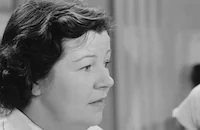Kathleen

Brief Synopsis
Cast & Crew
Harold S. Bucquet
Shirley Temple
Herbert Marshall
Laraine Day
Gail Patrick
Felix Bressart
Film Details
Technical Specs

Synopsis
Twelve-year-old Kathleen, the daydreaming daughter of wealthy widower John Davis, hates her shrewish governess, Mrs. Farrell, and prefers the company of antique shop owner Schoner. She tells Schoner that while she comes from a happy family, she has a friend, a girl on the hill, who is very lonely. One day, when John unexpectedly comes home from his office in time for dinner, she fantasizes that he will be so touched by her poem, "My Heart Cries Out," that he will beg forgiveness for his neglect. Instead, she is shattered to find that he is there to introduce her to Lorraine Bennett, his new girl friend. Her dislike for Lorraine puzzles John, and when Mrs. Farrell feigns injury from a firecracker device that Kathleen set up to stop her from snooping, he cannot comprehend her out-of-character behavior. Lorraine suggests that he call child specialist Dr. Montague Foster. Kathleen responds to Foster's kindness and, realizing that she is just lonely, he suggests that John fire Mrs. Farrell and hire Dr. Angela Martha Kent, a child psychologist who can spend the summer with Kathleen before leaving for a research trip to Buenos Aires. At first Kathleen is cool, but quickly grows to love her new governess, whom she nicknames "Angel." When asking John questions about Kathleen, Angela is shocked that he knows nothing about her and suggests that he dine at home every evening. Soon Kathleen tells Schoner that things are much better for the girl on the hill, and daydreams about Angela and her father falling in love. As Angela tries to guide John in becoming a more attentive father, he says that he will soon be taking a wife, and she assumes that he is talking about her. Because she is attracted to John, she is hurt to discover that he is referring to Lorraine, but asks Kathleen to give the woman a chance. Kathleen promises to do so, but fantasizes that she becomes a musical comedy star and has so much money that she gives Lorraine $100,000 to give John up, then has her arrested for accepting a bribe. Kathleen tries to get Angela to admit that she loves John, but instead Angela asks for advice from Dr. Foster, who tells her that she must try to transfer Kathleen's affection from herself to Lorraine. Meanwhile, Kathleen goes to Schoner and finds that he has to move to Philadelphia. She confesses that she is the girl on the hill, and he suggests that she bring Angela to meet him before he leaves. When Angela returns from seeing Dr. Foster, she acts more formal to Kathleen and does not go to Schoner's. That night, Angela tries to tell John what Kathleen has been planning, but he doesn't listen and asks her to stay with Kathleen while he and Lorraine are away on their wedding trip. She angrily tells him that Kathleen loathes Lorraine and chastises him for his lack of parental responsibilty. Kathleen overhears their quarrel and when Angela says that she is leaving, the child runs away after leaving a note saying that she is not wanted. Angela is just as distraught as John, and when Lorraine accuses her of manipulating Kathleen for her own purposes, he realizes what a shrew his fiancée really is. The next morning, when Schoner arrives in Philadelphia, he finds Kathleen in the moving van. She begs him to let her stay, but while she sleeps, he calls John. After Schoner tells her that "they" are coming for her, she imagines what it would be like if John came with Angela instead of Lorraine. When that happens, Kathleen thinks it is her most realistic dream, but John convinces her that it is no fantasy when he kisses Angela and says that the family is going home.

Director

Harold S. Bucquet
Cast

Shirley Temple

Herbert Marshall

Laraine Day

Gail Patrick

Felix Bressart

Nella Walker
Lloyd Corrigan
Guy Bellis
Wade Boteler

Charles Judels
Else Argal

Margaret Bert

James Flavin
Monty Collins

Joe Yule

Fern Emmett

Florence Bates
Thora Mathiason
Paul Godkin
Louise Jones
Forrest Price
Crew
Earl Brent
Roger Edens
Cedric Gibbons
George Haight
Mary C. Mccall Jr.
Conrad A. Nervig
Al Raboch
Wade B. Rubottom
Douglas Shearer
Kay Van Riper
Sidney Wagner
Franz Waxman
Edwin B. Willis

Photo Collections
Film Details
Technical Specs

Articles
Kathleen -
By Frank Miller

Kathleen -
Quotes
Trivia
Notes
The working title of this film was The Girl on the Hill. In the early stages of production, some sources listed the film's title as Cathleen. Kathleen was the first and only film that Shirley Temple made at M-G-M. Hollywood Reporter news items throughout late 1940 and early 1941 announced that Temple, who had recently left Twentieth Century-Fox and went under contract to M-G-M, was to star in several projects, among them Babes on Broadway and Panama Hattie ( and below), but she was replaced by other actresses. Her previous film was Young People, released in August 1940 by Twentieth Century-Fox (see AFI Catalog of Feature Films; F3.5257), and her next film was Miss Annie Rooney, released in May 1942 by United Artists (see below).
Although the Variety review called Kathleen "tedious" and said that Temple "does not tee off auspiciously" with her first M-G-M picture, several reviews praised Temple for her new, more grown-up performance. According to Temple's autobiography, neither she nor her mother were happy at M-G-M during Temple's short time at the studio and her mother turned down all other roles offered to the young actress. Temple and Herbert Marshall reprised their roles for a Lux Radio Theatre broadcast on December 27, 1943.
















